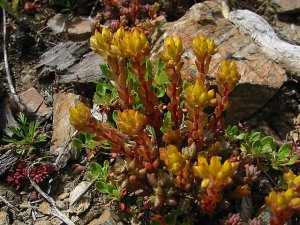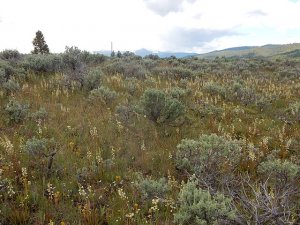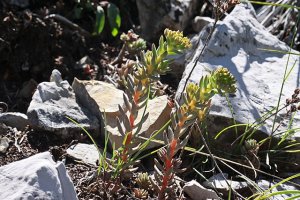Spearleaf stonecrop (Sedum lanceolatum) is a yellow flowering succulent plant found in the Pacific Northwest and across the western United States. Spearleaf stonecrop grows in exposed, rocky, mountainous habitats at moderate to high elevations, up to 4048 meters in the Rocky Mountains.

Spearleaf stonecrop is native to western portions of the United States and Canada. The plant thrived and evolved on nunataks and sky islands during glaciation events during the Ice Age. Its ability to withstand temperatures of down to -20 °F has allowed it to survive through these glaciation events.
This species of the Crassulaceae family also goes by the name lanceleaf stonecrop, and nunatak sedum. The names spearleaf and lanceleaf come from the pointed leaves that form in rosettes at the base of the plant and up the stems of the plant. Spearleaf stonecrop is also the host plant for the butterfly species Parnassius smintheus. The larvae of the butterfly species will feed on the leaves of spearleaf stonecrop while the adults typically feed on the nectar of the flowers.

Spearleaf Stonecrop Edibility and Culinary Use
Spearleaf stonecrop can be eaten raw, pickled or cooked. It’s similar to spinach in its edibility and it’s better when eaten raw. The plant has also been known to have a cucumber-like flavor.
The leaves are plump and retain quite a bit of moisture making it a great source of water when hiking giving you refreshment with every bite. The leaves are also rich in iron, calcium, and other essential vitamins so you’ll be getting a lot of punch out of them.
The leaves have a buttery texture making it easy to digest. It doesn’t take long for spearleaf stonecrop to grow so when in season you can always find fresh greens.
When picking the leaves, test the stems by applying a small amount of pressure. If it’s tender, then you can pick them without harming the plant. As with all wild edibles, make sure that you know what species it is.
The roots can be prepared by roasting or boiling them.
Spearleaf Stonecrop Health Benefits
Spearleaf stonecrop is rich in antioxidants and contains high levels of vitamins A, C, E among others. The plant also has calcium, potassium, magnesium, and selenium which are all good for your bones. As a succulent, spearleaf stonecrop is packed full of moisture, so adding it to your next salad or meal will also help in adding hydration.
Its high antioxidant levels also make it a great immune system booster.
The leaves can be used to treat certain skin conditions such as acne. It’s believed that the plant helps heal wounds because of its strong antioxidant properties. When treating skin conditions such as bites or rashes, it’s best to use spearleaf stonecrop as a poultice by mashing them into a ball.
A tea can be made from the leaves, stems, and flowers. This tea can be used to reduce inflammation and treat bladder problems. This tea has also been used by the Okanagan-Colville Indians to clean out the womb after childbirth, however, you should check with your physician before using it for these purposes.
Spearleaf stonecrop is also used to help with constipation as it has laxative properties when eaten in large amounts.
Spearleaf Stonecrop Cautions
Since spearleaf stonecrop is considered to be edible, it doesn’t mean that the plant is not poisonous. There are certain species of Sedum, like the spearleaf stonecrop, that are known to cause gastrointestinal issues including cramps, vomiting, and diarrhea especially when consumed in larger quantities.
Spearleaf stonecrop roots may contain high levels of oxalates which are known to cause kidney stones in some cases. Oxalates are usually found in the spearleaf stonecrop roots, so boiling or roasting the roots can help to reduce the amount of oxalates if you are sensitive to them
Spearleaf stonecrop can also aggravate autoimmune diseases such as lupus so it’s important to know your limits before planting the seeds, growing, or foraging the plants.
Sedums in general are not listed as toxic for people, however, they can be mildly toxic to pets and children.
Spearleaf stonecrop grows on rocky terrain which can also be where abandoned mining operations are located. Be sure to avoid plants located in these areas since the soil and water in these areas can contain heavy metals which can be absorbed into the plant, especially since spearleaf stonecrop is a succulent.
It’s best to eat a small amount of spearleaf stonecrop to see how your body will react before choosing to consume it.
Conclusion

Spearleaf stonecrop is a good source of vitamins and minerals, however, eating too much can result in side effects such as diarrhea and vomiting. The leaves can be used as a poultice for skin conditions, to help heal wounds, and treat bladder problems. The roots can aid with constipation.
This hardy succulent can deal with both cold and heat extremes making it a great plant to forage when hiking in mountainous regions of the Pacific Northwest.
—————Written by Jared DeValk
Jared DeValk is an author, writer, and entrepreneur who in his free time can be caught hiking, planting berry bushes, or doing home repairs and improvements. Jared's varied life experience and passion for research empassions him to write knowledgeably about many topics such as , Health & Wellness, Real Estate, Finance, Business, Cryptocurrency, Home Improvement, Agriculture, Camping/Hiking, and many more. Jared can be reached directly for speaking, marketing, and writing inquiries at JaredDeValk.com.
Many of our readers find that subscribing to Eat The Planet is the best way to make sure they don't miss any of our valuable information about wild edibles.
See our privacy policy for more information about ads on this site






